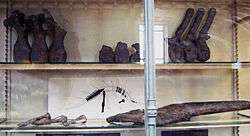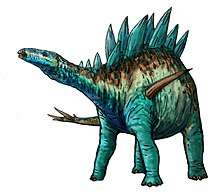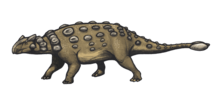Loricatosaurus
Loricatosaurus (meaning "armored lizard") is a dinosaur of family Stegosauridae from Callovian-age (Middle Jurassic) rocks of England and France.[1]
| Loricatosaurus | |
|---|---|
 | |
| Fossils originally referred to Lexovisaurus, Muséum national d'histoire naturelle, Paris. | |
| Scientific classification | |
| Kingdom: | Animalia |
| Phylum: | Chordata |
| Clade: | Dinosauria |
| Order: | †Ornithischia |
| Suborder: | †Stegosauria |
| Family: | †Stegosauridae |
| Genus: | †Loricatosaurus Maidment et al., 2008 |
| Type species | |
| †Loricatosaurus priscus Nopcsa, 1911 | |
| Synonyms | |
| |
Discovery and naming
Loricatosaurus is known from remains previously assigned to Lexovisaurus. These remains were discovered at the Fletton brick pit in the Oxford Clay Formation, Fletton, Peterborough, England, by Alfred Leeds during November 1901.[2] The material was later assigned to Stegosaurus priscus by Baron Franz Nopcsa in 1911. However, upon later review of the material in 2008, Susannah Maidment and colleagues determined that Lexovisaurus was based upon nondiagnostic remains, and coined a new genus for the other specimens. The species name, priscus, comes from the oldest name associated with diagnostic specimens, Baron Franz Nopcsa's "Stegosaurus" priscus of 1911. It is known from only two partial skeletons. Contrary to previous reports (as Lexovisaurus), a shoulder spine is not present in the known material; the possible spine is more likely from the tail.[1]
The genus name Loricatosaurus derives from the Latin "loricatus" (meaning armoured) and the Greek "sauros" (meaning lizard). The specific name derives from the Latin "priscus" (meaning ancient).
Description
The holotype (BMNH R3167) is a partial skeleton, including two cervical, six dorsal, and 16 caudal vertebrae, a right humerus and right ulna, some carpus, two metacarpals (one incomplete), a partial ilia, partial right ischium, and pubis, the left femur, partial tibia and fibula, fused tarsals, and some armour plates. This material now resides in the British Museum of Natural History's palaeontology collection. Another referred specimen (MHBR 001), from an unnamed unit referred to as the Marnes a Belemnopsis latesulcatus Formation from the lower Callovian, Middle Jurassic of Le Fresne d’Argences, Calvados, Normandy, France, includes neck, back and tail vertebrae, a left upper arm, right thigh, shin and calf, and some armour plates.[1]
Multiple phylogenetic analyses carried out by S. Maidment and O. Mateus between 2008 and 2010 place Loricatosaurus as a basal genus within the family Stegosauridae.[1][3][4]
See also
References
- Maidment, Susannah C.R.; Norman, David B.; Barrett, Paul M.; Upchurch, Paul (2008). "Systematics and phylogeny of Stegosauria (Dinosauria: Ornithischia)". Journal of Systematic Palaeontology. 6 (4): 1. doi:10.1017/S1477201908002459.
- J. W. Hulke. 1887. Note on some dinosaurian remains in the collection of A. Leeds, Esq. Part I. Ornithopsis leedsii. Part II. Omosaurus, sp. Geological Magazine, decade 3 4:375-376
- Octávio, Mateus; Maidment, Susannah C. R.; Nicolai A., Christiansen (22 May 2009). "A new long-necked 'sauropod-mimic' stegosaur and the evolution of the plated dinosaurs". Proceedings of the Royal Society of London B: Biological Sciences. 276 (1663): 1815–1821. doi:10.1098/rspb.2008.1909. ISSN 0962-8452. PMC 2674496. PMID 19324778.
- Susannah C. R., Maidment (7 September 2010). "Stegosauria: a historical review of the body fossil record and phylogenetic relationships". Swiss Journal of Geosciences. 103 (2): 199–210. doi:10.1007/s00015-010-0023-3. ISSN 1661-8726.
| Wikimedia Commons has media related to Loricatosaurus. |
| Wikispecies has information related to Loricatosaurus |

